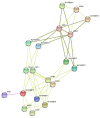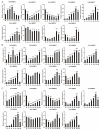Identification of YABBY Transcription Factors and Their Function in ABA and Salinity Response in Nelumbo nucifera
- PMID: 36679092
- PMCID: PMC9866709
- DOI: 10.3390/plants12020380
Identification of YABBY Transcription Factors and Their Function in ABA and Salinity Response in Nelumbo nucifera
Abstract
The plant-specific transcription factor family YABBY plays important roles in plant responses to biotic and abiotic stresses. Although the function of YABBY has been identified in many species, systematic analysis in lotus (Nelumbo nucifera) is still relatively lacking. The present study aimed to characterize all of the YABBY genes in lotus and obtain better insights into NnYABBYs in response to salt stress by depending on ABA signaling. Here, we identified nine YABBY genes by searching the whole lotus genome based on the conserved YABBY domain. Further analysis showed that these members were distributed on six different chromosomes and named from YABBY1 to YABBY9, which were divided into five subgroups, including YAB1, YAB2, YAB5, INO, and CRC. The analysis of cis-elements in promotors revealed that NnYABBYs could be involved in plant hormone signaling and plant responses to abiotic stresses. Quantitative real-time PCR (qRT-PCR) showed that NnYABBYs could be up-regulated or down-regulated by ABA, fluridone, and salt treatment. Subcellular localization indicated that NnYABBY4, NnYABBY5, and NnYABBY6 were mainly localized in the cell membrane and cytoplasm. In addition, the intrinsic trans-activity of NnYABBY was tested by a Y2H assay, which revealed that NnYABBY4, NnYABBY5, and NnYABBY6 are deprived of such a property. This study provided a theoretical basis and reference for the functional research of YABBY for the molecular breeding of lotus.
Keywords: ABA; Nelumbo nucifera; YABBY; salt stress; transcription factor.
Conflict of interest statement
The authors declare no conflict of interest.
Figures










Similar articles
-
Identification of the NAC Transcription Factors and Their Function in ABA and Salinity Response in Nelumbo nucifera.Int J Mol Sci. 2022 Oct 16;23(20):12394. doi: 10.3390/ijms232012394. Int J Mol Sci. 2022. PMID: 36293250 Free PMC article.
-
Genome-wide identification and comparative analysis of YABBY transcription factors in oil tea and tea tree.3 Biotech. 2024 Apr;14(4):113. doi: 10.1007/s13205-024-03940-9. Epub 2024 Mar 19. 3 Biotech. 2024. PMID: 38515867 Free PMC article.
-
Genome-wide analysis of the YABBY family in soybean and functional identification of GmYABBY10 involvement in high salt and drought stresses.Plant Physiol Biochem. 2017 Oct;119:132-146. doi: 10.1016/j.plaphy.2017.08.026. Epub 2017 Aug 30. Plant Physiol Biochem. 2017. PMID: 28866235
-
Comprehensive Analysis for GRF Transcription Factors in Sacred Lotus (Nelumbo nucifera).Int J Mol Sci. 2022 Jun 15;23(12):6673. doi: 10.3390/ijms23126673. Int J Mol Sci. 2022. PMID: 35743113 Free PMC article. Review.
-
Roles of YABBY transcription factors in the modulation of morphogenesis, development, and phytohormone and stress responses in plants.J Plant Res. 2020 Nov;133(6):751-763. doi: 10.1007/s10265-020-01227-7. Epub 2020 Oct 8. J Plant Res. 2020. PMID: 33033876 Review.
Cited by
-
Genome-wide identification of YABBY gene family and its expression pattern analysis in Astragalus mongholicus.Plant Signal Behav. 2024 Dec 31;19(1):2355740. doi: 10.1080/15592324.2024.2355740. Epub 2024 May 22. Plant Signal Behav. 2024. PMID: 38776425 Free PMC article.
-
Genome-Wide Identification and Co-Expression Networks of WOX Gene Family in Nelumbo nucifera.Plants (Basel). 2024 Mar 4;13(5):720. doi: 10.3390/plants13050720. Plants (Basel). 2024. PMID: 38475567 Free PMC article.
-
The YABBY Transcription Factor, SlYABBY2a, Positively Regulates Fruit Septum Development and Ripening in Tomatoes.Int J Mol Sci. 2024 May 10;25(10):5206. doi: 10.3390/ijms25105206. Int J Mol Sci. 2024. PMID: 38791245 Free PMC article.
-
Molecular Characterization and Expression Analysis of YABBY Genes in Chenopodium quinoa.Genes (Basel). 2023 Nov 19;14(11):2103. doi: 10.3390/genes14112103. Genes (Basel). 2023. PMID: 38003046 Free PMC article.
-
The influence of spatial distribution and transcriptional regulation of secondary metabolites on the bioactivities of Adenophora triphylla (Japanese lady bell).Heliyon. 2024 Sep 13;10(18):e37898. doi: 10.1016/j.heliyon.2024.e37898. eCollection 2024 Sep 30. Heliyon. 2024. PMID: 39323821 Free PMC article.
References
-
- Shukla S., Park J., Park J.H., Lee J.S., Kim M. Development of lotus root fermented sugar syrup as a functional food supplement/condiment and evaluation of its physicochemical, nutritional and microbiological properties. J. Food Sci. Technol. 2018;55:619–629. doi: 10.1007/s13197-017-2971-3. - DOI - PMC - PubMed
Grants and funding
LinkOut - more resources
Full Text Sources

